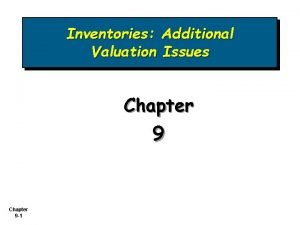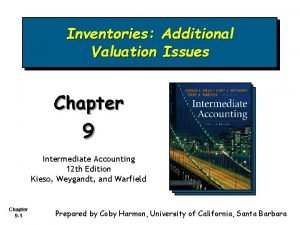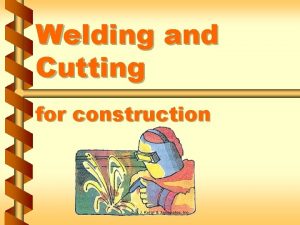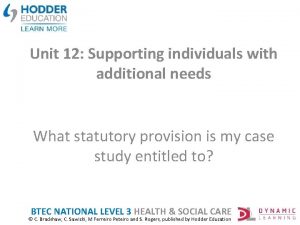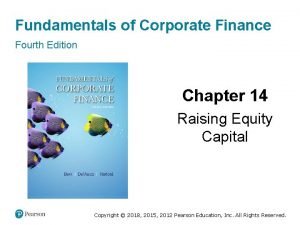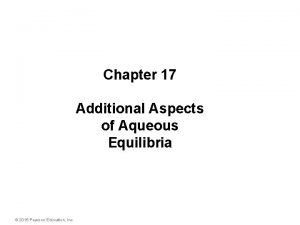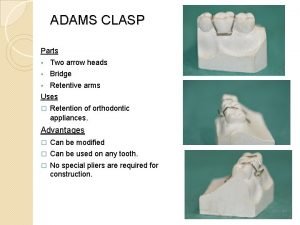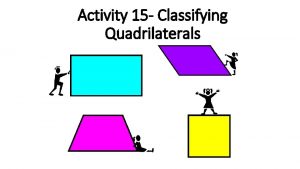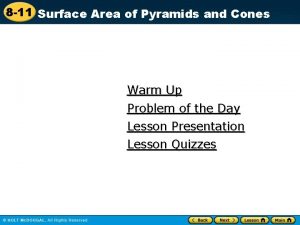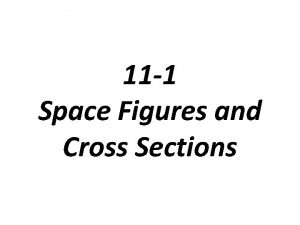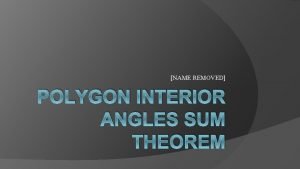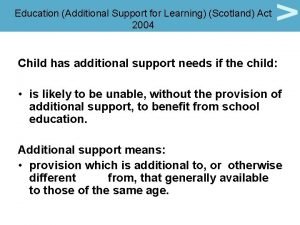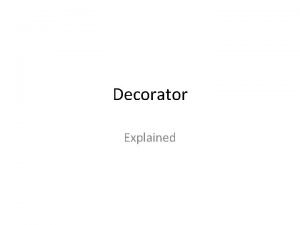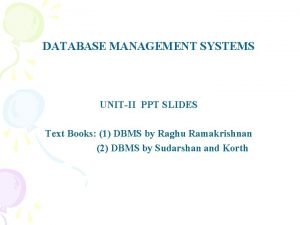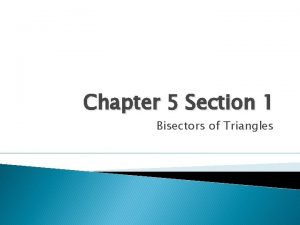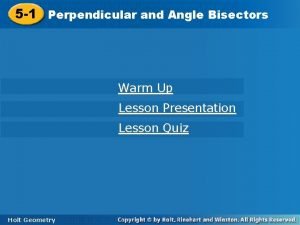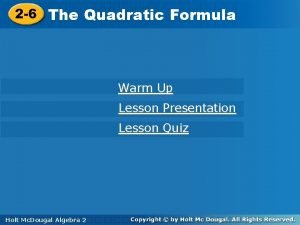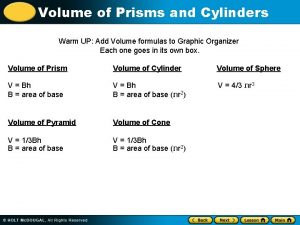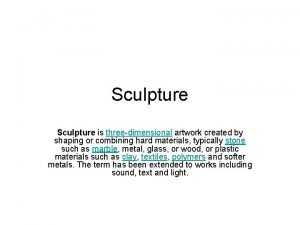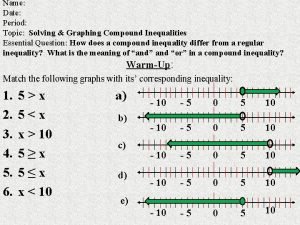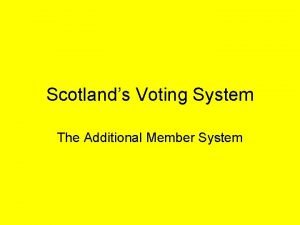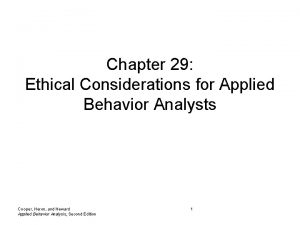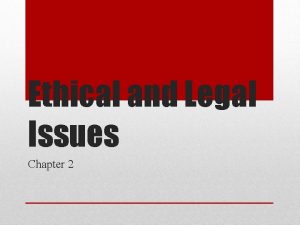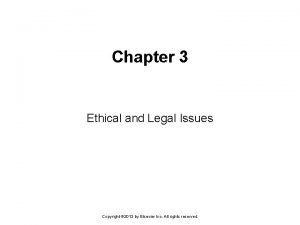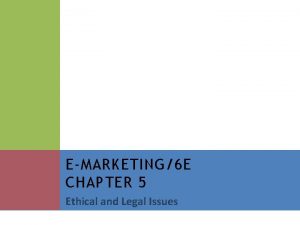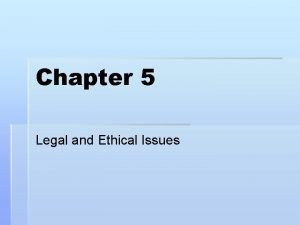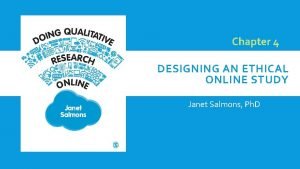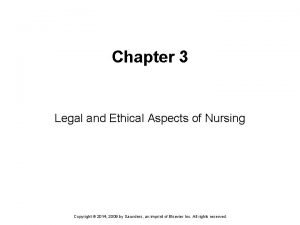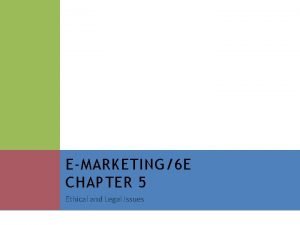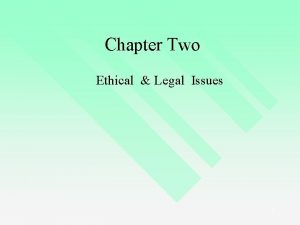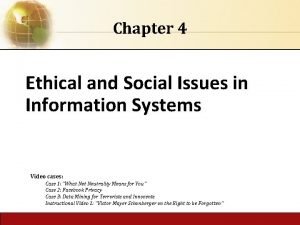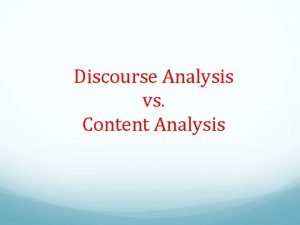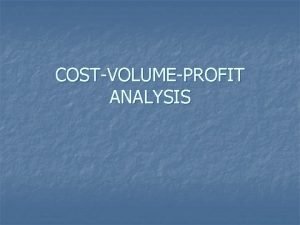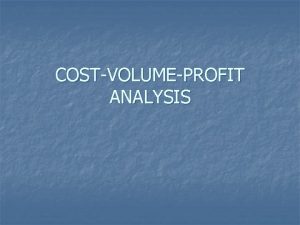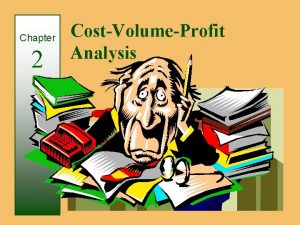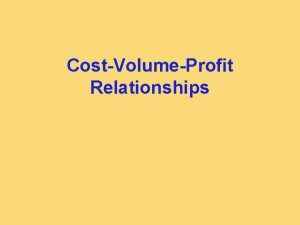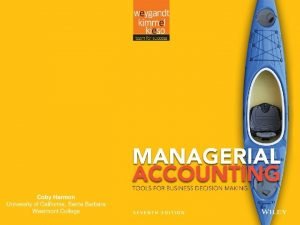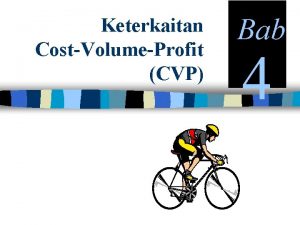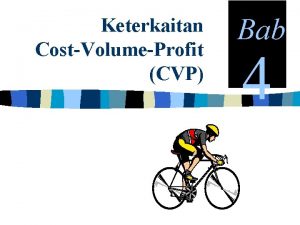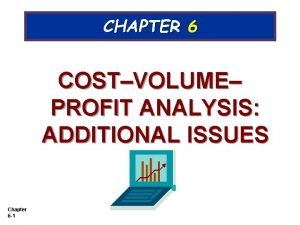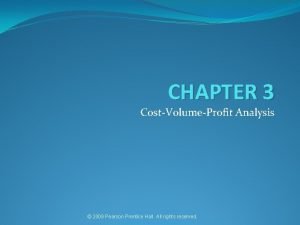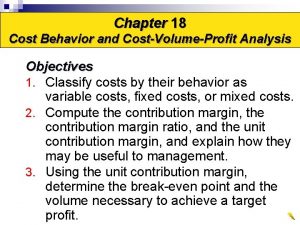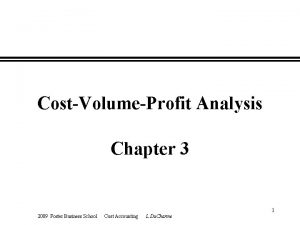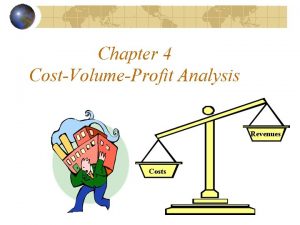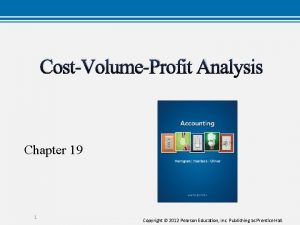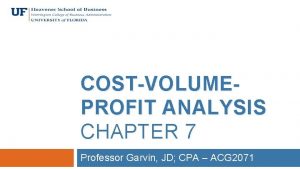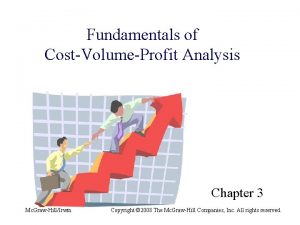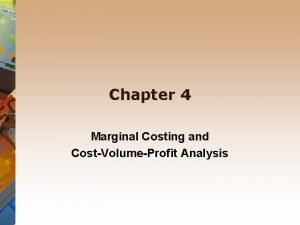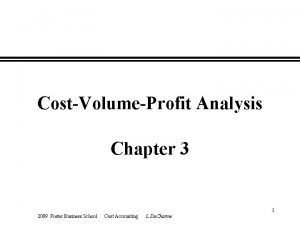20 1 Chapter 20 CostVolumeProfit Analysis Additional Issues






























































- Slides: 62

20 -1

Chapter 20 Cost-Volume-Profit Analysis: Additional Issues Learning Objectives After studying this chapter, you should be able to: [1] Describe the essential features of a cost-volume-profit income statement. [2] Apply basic CVP concepts. [3] Explain the term sales mix and its effects on break-even sales. [4] Determine sales mix when a company has limited resources. [5] Understand how operating leverage affects profitability. 20 -2

Preview of Chapter 20 Financial and Managerial Accounting Weygandt Kimmel Kieso 20 -3

Cost-Volume-Profit (CVP) Review CVP analysis is: 20 -4 u The study of the effects of changes in costs and volume on a company’s profit. u Important to profit planning. u Critical in management decisions such as: ► determining product mix, ► maximizing use of production facilities, ► setting selling prices. LO 1 Describe the essential features of a cost-volume-profit income statement.

Cost-Volume-Profit (CVP) Review Basic Concepts 20 -5 u Management often wants the information reported in a special format income statement. u CVP income statement is for internal use only: ► Costs and expenses classified as fixed or variable. ► Reports contribution margin as a total amount and on a per unit basis. LO 1 Describe the essential features of a cost-volume-profit income statement.

Cost-Volume-Profit (CVP) Review Basic Concepts 20 -6 Illustration 20 -1 Basic CVP income statement LO 1 Describe the essential features of a cost-volume-profit income statement.

Cost-Volume-Profit (CVP) Review Basic Concepts Illustration 20 -2 Detailed CVP income statement 20 -7 LO 1 Describe the essential features of a cost-volume-profit income statement.

Blue Diamond, Inc. sold 20, 000 units and recorded sales of $800, 000 for the first quarter of 2014. In making the sales, the company incurred the following costs and expenses. (a) Prepare a CVP income statement for the quarter ended March 31, 2014. (b) Compute the contribution margin per unit. (c) Compute the contribution margin ratio. 20 -8 LO 1 Describe the essential features of a cost-volume-profit income statement.

(a) Prepare a CVP income statement for the quarter ended March 31, 2014. 20 -9 LO 1

(b) Compute the contribution margin per unit. ÷ 20, 000 = $40. 00 ÷ 20, 000 = $21. 60 $18. 40 Per unit 20 -10 LO 1

(c) Compute the contribution margin ratio. ÷ 800, 000 = 46% or, $18. 40 ÷ $40 = 46% 20 -11 LO 1

Cost-Volume-Profit (CVP) Review Basic Computations – Break-Even Analysis Illustration: Vargo Video’s CVP income statement (Ill. 6 -2) shows that total contribution margin is $320, 000, and the company’s contribution margin per unit is $200. Contribution margin can also be expressed in the form of the contribution margin ratio which in the case of Vargo is 40% ($200 ÷ $500). Illustration 20 -3 and 20 -4 20 -12 LO 2 Apply basic CVP concepts.

Cost-Volume-Profit (CVP) Review Basic Computations – Target Net Income Once a company achieves break-even sales, a sales goal can be set that will result in a target net income Illustration: Assuming Vargo’s target net income is $250, 000, required sales in units and dollars to achieve this are: Illustration 20 -5 and 20 -6 20 -13 LO 2 Apply basic CVP concepts.

Cost-Volume-Profit (CVP) Review Basic Computations – Margin of Safety Margin of safety u cells us how far sales can drop before the company will operate at a loss. u can be expressed in dollars or as a ratio. Illustration: Assume Vargo’s sales are $800, 000: Illustration 20 -7 and 20 -8 20 -14 LO 2 Apply basic CVP concepts.

Cost-Volume-Profit (CVP) Review CVP and Changes in the Business Environment Illustration: Original camcorder sales and cost data for Vargo Video: Illustration 20 -9 20 -15 LO 2 Apply basic CVP concepts.

Cost-Volume-Profit (CVP) Review CVP and Changes in the Business Environment Case I: A competitor is offering a 10% discount on the selling price of its camcorders. Management must decide whether to offer a similar discount. Question: What effect will a 10% discount on selling price ($500 x 10% = $50) have on the breakeven point? Illustration 20 -10 20 -16 LO 2 Apply basic CVP concepts.

Cost-Volume-Profit (CVP) Review CVP and Changes in the Business Environment Case II: Management invests in new robotic equipment that will lower the amount of direct labor required to make camcorders. Estimates are that total fixed costs will increase 30% and that variable cost per unit will decrease 30%. Question: What effect will the new equipment have on the sales volume required to break even? Illustration 20 -11 20 -17 LO 2 Apply basic CVP concepts.

Cost-Volume-Profit (CVP) Review CVP and Changes in the Business Environment Case III: Vargo’s principal supplier of raw materials has just announced a price increase. The higher cost is expected to increase the variable cost of camcorders by $25 per unit. Management decides to hold the line on the selling price of the camcorders. It plans a cost-cutting program that will save $17, 500 in fixed costs per month. Vargo is currently realizing monthly net income of $80, 000 on sales of 1, 400 camcorders. Question: What increase in units sold will be needed to maintain the same level of net income? 20 -18 LO 2 Apply basic CVP concepts.

Cost-Volume-Profit (CVP) Review CVP and Changes in the Business Environment Case III: Variable cost per unit increases to $325 ($300 + $25). Fixed costs are reduced to $182, 500 ($200, 000 - $17, 500). Contribution margin per unit becomes $175 ($500 - $325). Illustration 20 -12 20 -19 LO 2 Apply basic CVP concepts.

Cost-Volume-Profit (CVP) Review Question Croc Catchers calculates its contribution margin to be less than zero. Which statement is true? a. Its fixed costs are less than the variable cost per unit. b. Its profits are greater than its total costs. c. The company should sell more units. d. Its selling price is less than its variable costs. 20 -20 LO 2 Apply basic CVP concepts.

20 -21

Sales Mix Break-Even Sales in Units 20 -22 u Sales mix is the relative percentage in which a company sells its products. u If a company’s unit sales are 80% printers and 20% computers, its sales mix is 80% to 20%. u Sales mix is important because different products often have very different contribution margins. LO 3 Explain the term sales mix and its effects on break-even sales.

Sales Mix Break-Even Sales in Units Companies can compute break-even sales for a mix of two or more products by determining the weighted-average unit contribution margin of all the products. Illustration: Vargo Video sells not only camcorders but TV sets as well. Vargo sells its two products in the following amounts: 1, 500 camcorders and 500 TVs. The sales mix, expressed as a function of total units sold, is as follows. Illustration 20 -13 20 -23 LO 3 Explain the term sales mix and its effects on break-even sales.

Sales Mix Break-Even Sales in Units Additional information related to Vargo Video. Illustration 20 -13 Illustration 20 -14 20 -24 LO 3 Explain the term sales mix and its effects on break-even sales.

Sales Mix Break-Even Sales in Units First, determine the weighted-average contribution margin. Illustration 20 -14 Illustration 20 -15 20 -25 LO 3 Explain the term sales mix and its effects on break-even sales.

Sales Mix Break-Even Sales in Units Second, use the weighted-average unit contribution margin to compute the break-even point in units Illustration 20 -15 Illustration 20 -16 20 -26 LO 3 Explain the term sales mix and its effects on break-even sales.

Sales Mix Break-Even Sales in Units u u With a break-even point of 1, 000 units, Vargo must sell: ► 750 Camcorders (1, 000 units x 75%) ► 250 TVs (1, 000 units x 25%) At this level, the total contribution margin will equal the fixed costs of $275, 000. Illustration 20 -17 20 -27 LO 3 Explain the term sales mix and its effects on break-even sales.

Sales Mix Break-Even Sales in Dollars 20 -28 u Works well if the company has many products. u Calculates break-even point in terms of sales dollars for ► divisions or ► product lines, ► NOT individual products. LO 3 Explain the term sales mix and its effects on break-even sales.

Sales Mix Break-Even Sales in Dollars Illustration: Kale Garden Supply Company has two divisions. Illustration 20 -18 Illustration 20 -19 20 -29 LO 3 Explain the term sales mix and its effects on break-even sales.

Sales Mix Break-Even Sales in Dollars First, determine the weighted-average contribution margin. Illustration 20 -20 Illustration 20 -21 Second, calculate break-even point in dollars. 20 -30 LO 3 Explain the term sales mix and its effects on break-even sales.

Sales Mix Break-Even Sales in Dollars u u 20 -31 With break-even sales of $937, 500 and a sales mix of 20% to 80%, Kale must sell: ► $187, 500 from the Indoor Plant division ► $750, 000 from the Outdoor Plant division If the sales mix becomes 50% to 50%, the weighted average contribution margin ratio changes to 35%, resulting in a lower break-even point of $857, 143. LO 3 Explain the term sales mix and its effects on break-even sales.

Sales Mix Review Question Net income will be: 20 -32 a. Greater if more higher-contribution margin units are sold than lower-contribution margin units. b. Greater is more lower-contribution margin units are sold than higher-contribution margin units. c. Equal as song as total sales remain equal, regardless of which products are sold. Unaffected by changes in the mix of products sold. LO 3 Explain the term sales mix and its effects on break-even sales.

20 -33

Sales Mix Determining Sales Mix with Limited Resources u All companies have limited resources whether it be floor space, raw materials, direct labor hours, etc. u Management must decide which products to sell to maximize net income. Illustration: Vargo makes camcorders and TVs. Machine capacity is limited to 3, 600 hours per month. Illustration 20 -22 20 -34 LO 4

Sales Mix Determining Sales Mix with Limited Resources Calculate the contribution margin per unit of limited resource. Illustration 20 -23 Management should produce more camcorders if demand exists or else increase machine capacity. 20 -35 LO 4 Determine sales mix when a company has limited resources.

Sales Mix Determining Sales Mix with Limited Resources If Vargo is able to increase machine capacity from 3, 600 hours to 4, 200 hours, the additional 600 hours could be used to produce either the camcorders or TVs. Illustration 20 -24 To maximize net income, all 600 hours should be used to produce and sell camcorders. 20 -36 LO 4 Determine sales mix when a company has limited resources.

Sales Mix Theory of Constraints 20 -37 u Approach used to identify and manage constraints so as to achieve company goals. u Company must continually ► identify its constraints and ► find ways to reduce or eliminate them, where appropriate. LO 4 Determine sales mix when a company has limited resources.

Sales Mix Review Question If the contribution margin per unit is $15 and it takes 3. 0 machine hours to produce the unit, the contribution margin per unit of limited resource is: a. $25. b. $5. c. $4. d. No correct answer is given. 20 -38 LO 4 Determine sales mix when a company has limited resources.

20 -39

Cost Structure and Operating Leverage Cost Structure is the relative proportion of fixed versus variable costs that a company incurs. 20 -40 u May have a significant effect on profitability. u Company must carefully choose its cost structure. LO 5 Understand how operating leverage affects profitability.

Cost Structure and Operating Leverage Illustration: Vargo Video and one of its competitors, New Wave Company, both make camcorders. Vargo Video uses a traditional, labor-intensive manufacturing process. New Wave Company has invested in a completely automated system. The factory employees are involved only in setting up, adjusting, and maintaining the machinery. Illustration 20 -25 CVP income statements 20 -41 LO 5 Understand how operating leverage affects profitability.

Cost Structure and Operating Leverage Effect on Contribution Margin Ratio Illustration 20 -25 First let’s look at the contribution margin ratios. Illustration 20 -26 20 -42 LO 5 Understand how operating leverage affects profitability.

Cost Structure and Operating Leverage Effect on Contribution Margin Ratio Illustration 20 -26 20 -43 u New Wave contributes 80 cents to net income for each dollar of increased sales while Vargo only contributes 40 cents. u New Wave’s cost structure which relies on fixed costs is more sensitive to changes in sales. LO 5 Understand how operating leverage affects profitability.

Cost Structure and Operating Leverage Effect on Break-Even Point Calculate the break-even point. 20 -44 Illustration 20 -27 u New Wave needs to generate $150, 000 more in sales than Vargo to break-even. u Because of the greater break-even sales required, New Wave is a riskier company than Vargo. LO 5 Understand how operating leverage affects profitability.

Cost Structure and Operating Leverage Effect on Margin of Safety Computation of margin of safety ratio 20 -45 Illustration 20 -28 u The difference in ratios reflects the difference in risk between New Wave and Vargo. u Vargo can sustain a 38% decline in sales before operating at a loss versus only a 19% decline for New Wave. LO 5 Understand how operating leverage affects profitability.

Cost Structure and Operating Leverage 20 -46 u Extent that net income reacts to a given change in sales. u Higher fixed costs relative to variable costs cause a company to have higher operating leverage. u When sales revenues are increasing, high operating leverage means that profits will increase rapidly. u When sales revenues are declining, too much operating leverage can have devastating consequences. LO 5 Understand how operating leverage affects profitability.

Cost Structure and Operating Leverage Degree of Operating Leverage u Provides a measure of a company’s earnings volatility. u Computed by dividing total contribution margin by net income. Illustration 20 -29 New Wave’s earnings would go up (or down) by about two times (5. 33 ÷ 2. 67 = 1. 99) as much as Vargo’s with an equal increase in sales. 20 -47 LO 5 Understand how operating leverage affects profitability.

Cost Structure and Operating Leverage Review Question The degree of operating leverage: a. Can be computed by dividing total contribution margin by net income. b. Provides a measure of the company’s earnings volatility. c. Affects a company’s break-even point. d. All of the above. 20 -48 LO 5 Understand how operating leverage affects profitability.

20 -49

APPENDIX 20 A ABSORPTION VERSUS VARIABLE COSTING Under variable costing, product costs consist of: u Direct Materials u Direct Labor u Variable Manufacturing Overhead The difference between absorption and variable costing is: Illustration 20 A-1 20 -50 LO 6 Explain the difference between absorption costing and variable costing.

APPENDIX 20 A ABSORPTION VERSUS VARIABLE COSTING The difference between absorption and variable costing: 20 -51 u Under both costing methods, selling and administrative expenses are treated as period costs. u Companies may not use variable costing for external financial reports because GAAP requires that fixed manufacturing overhead be treated as a product cost. LO 6 Explain the difference between absorption costing and variable costing.

APPENDIX 20 A ABSORPTION VERSUS VARIABLE COSTING Comparing Absorption with Variable Costing Illustration: Premium Products Corporation manufactures a polyurethane sealant, called Fix-It, for car windshields. Relevant data for Fix-It in January 2013, the first month of production, are as follows. Illustration 20 A-2 20 -52 LO 6 Explain the difference between absorption costing and variable costing.

APPENDIX 20 A ABSORPTION VERSUS VARIABLE COSTING Comparing Absorption with Variable Costing Per unit manufacturing cost under each approach. Illustration 20 A-3 The manufacturing cost per unit is $4 ($13 -$9) higher for absorption costing because fixed manufacturing costs are treated as product costs. 20 -53 LO 6 Explain the difference between absorption costing and variable costing.

APPENDIX 20 A ABSORPTION VERSUS VARIABLE COSTING Absorption Costing Example 20 -54 Illustration 20 A-4 LO 6

APPENDIX 20 A ABSORPTION VERSUS VARIABLE COSTING Variable Costing Example 20 -55 Illustration 20 A-5 LO 6

APPENDIX 20 A ABSORPTION VERSUS VARIABLE COSTING An Extended Example u If production volume exceeds sales volume, net income under absorption costing will exceed net income under variable costing by the amount of fixed manufacturing costs included in ending inventory that results from units produced but not sold during the period. u 20 -56 If production volume is less than sales volume, net income under absorption costing will be less than under variable costing by the amount of fixed manufacturing costs included in the units sold during the period that were not produced during the period. LO 7

APPENDIX 20 A ABSORPTION VERSUS VARIABLE COSTING An Extended Example 20 -57 Illustration 20 A-14 LO 7 Discuss net income effects under absorption costing versus variable costing.

APPENDIX 20 A ABSORPTION VERSUS VARIABLE COSTING Review Question Fixed manufacturing overhead costs are recognized as: a. Period costs under absorption costing. b. Product costs under absorption costing. c. Product costs under variable costing. d. Part of ending inventory costs under both absorption and variable costing. 20 -58 LO 7 Discuss net income effects under absorption costing versus variable costing.

APPENDIX 20 A ABSORPTION VERSUS VARIABLE COSTING Decision-Making Concerns 20 -59 u Generally accepted accounting principles require that absorption costing be used for the costing of inventory for external reporting purposes. u Net income measured under GAAP (absorption costing) is often used internally to ► evaluate performance, ► justify cost reductions, or ► evaluate new projects. LO 8 Discuss the merits of absorption versus variable costing for management decision making.

APPENDIX 20 A ABSORPTION VERSUS VARIABLE COSTING Decision-Making Concerns 20 -60 u Some companies have recognized that net income calculated using GAAP does not highlight differences between variable and fixed costs and may lead to poor business decisions. u These companies use variable costing for internal reporting purposes. LO 8 Discuss the merits of absorption versus variable costing for management decision making.

APPENDIX 20 A ABSORPTION VERSUS VARIABLE COSTING Potential Advantages of Variable Costing 20 -61 u The use of variable costing is consistent with cost– volume–profit analysis. u Net income under variable costing is unaffected by changes in production levels. Instead, it is closely tied to changes in sales. u The presentation of fixed costs in the variable costing approach makes it easier to identify fixed costs and to evaluate their impact on the company’s profitability. LO 8 Discuss the merits of absorption versus variable costing for management decision making.

Copyright “Copyright © 2012 John Wiley & Sons, Inc. All rights reserved. Reproduction or translation of this work beyond that permitted in Section 117 of the 1976 United States Copyright Act without the express written permission of the copyright owner is unlawful. Request for further information should be addressed to the Permissions Department, John Wiley & Sons, Inc. The purchaser may make back-up copies for his/her own use only and not for distribution or resale. The Publisher assumes no responsibility for errors, omissions, or damages, caused by the use of these programs or from the use of the information contained herein. ” 20 -62
 Chapter 9 inventories additional valuation issues
Chapter 9 inventories additional valuation issues Lower of cost or market
Lower of cost or market Fire watchers are additional personnel
Fire watchers are additional personnel Supporting individuals with additional needs
Supporting individuals with additional needs Presenting yourself on the uc application
Presenting yourself on the uc application School health additional referral program
School health additional referral program Ipo chart
Ipo chart Additional aspects of aqueous equilibria
Additional aspects of aqueous equilibria Additional aspects of aqueous equilibria
Additional aspects of aqueous equilibria 10-5 secant lines and segments
10-5 secant lines and segments Coffin spring uses
Coffin spring uses Flow chart quadrilaterals
Flow chart quadrilaterals Sa of pyramid
Sa of pyramid 11-1 additional practice space figures and cross sections
11-1 additional practice space figures and cross sections Letter asking for information
Letter asking for information Additional roles reimbursement scheme
Additional roles reimbursement scheme Polygon interior angles theorem
Polygon interior angles theorem Tattle tooth program
Tattle tooth program Additional support for learning act 2004
Additional support for learning act 2004 Attach additional responsibilities to an object dynamically
Attach additional responsibilities to an object dynamically Introduction to database management system ppt
Introduction to database management system ppt 5-1 bisectors of triangles
5-1 bisectors of triangles Perpendicular and angle bisectors worksheet
Perpendicular and angle bisectors worksheet 2-6 additional practice the quadratic formula
2-6 additional practice the quadratic formula Volume of prism and cylinders worksheet
Volume of prism and cylinders worksheet A process in sculpture putting additional parts
A process in sculpture putting additional parts 1-6 additional practice compound inequalities
1-6 additional practice compound inequalities Additional member system scotland
Additional member system scotland Grantham additional needs fellowship
Grantham additional needs fellowship Additional process
Additional process Pros and cons of ams
Pros and cons of ams Fsmq
Fsmq Additional topics in trigonometry
Additional topics in trigonometry Ethical issues in applied behavior analysis
Ethical issues in applied behavior analysis Chapter 20 today's issues in africa
Chapter 20 today's issues in africa Chapter 2 ethical and legal issues
Chapter 2 ethical and legal issues Medical legal and ethical issues chapter 3
Medical legal and ethical issues chapter 3 Legal and ethical issues chapter 3
Legal and ethical issues chapter 3 Chapter 20 today's issues in africa
Chapter 20 today's issues in africa Legal and ethical issues chapter 5
Legal and ethical issues chapter 5 Medical legal and ethical issues chapter 3
Medical legal and ethical issues chapter 3 Chapter 11 today's issues in latin america
Chapter 11 today's issues in latin america Chapter 6 legal and ethical issues
Chapter 6 legal and ethical issues Chapter 5 legal and ethical issues
Chapter 5 legal and ethical issues Chapter 4 ethical issues
Chapter 4 ethical issues Ethical issues in qualitative research chapter 4
Ethical issues in qualitative research chapter 4 Chapter 3 legal and ethical aspects of nursing
Chapter 3 legal and ethical aspects of nursing Chapter 2 ethical and legal issues
Chapter 2 ethical and legal issues Ethical and legal issues chapter 2
Ethical and legal issues chapter 2 Chapter 5 legal and ethical issues
Chapter 5 legal and ethical issues Legal and ethical issues chapter 5
Legal and ethical issues chapter 5 Chapter 2 ethical and legal issues
Chapter 2 ethical and legal issues Chapter 4 ethical issues
Chapter 4 ethical issues Chapter 4 ethical issues
Chapter 4 ethical issues Chapter 4 ethical and social issues in information systems
Chapter 4 ethical and social issues in information systems Chapter 6 legal and ethical issues
Chapter 6 legal and ethical issues Chapter 6 legal and ethical issues
Chapter 6 legal and ethical issues Chapter 3 legal and ethical issues
Chapter 3 legal and ethical issues Chapter 23 today's issues southwest asia
Chapter 23 today's issues southwest asia What are structured analysis tools
What are structured analysis tools Static malware analysis vs dynamic malware analysis
Static malware analysis vs dynamic malware analysis Content vs discourse analysis
Content vs discourse analysis Differences between error analysis and contrastive analysis
Differences between error analysis and contrastive analysis
